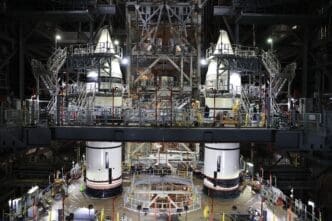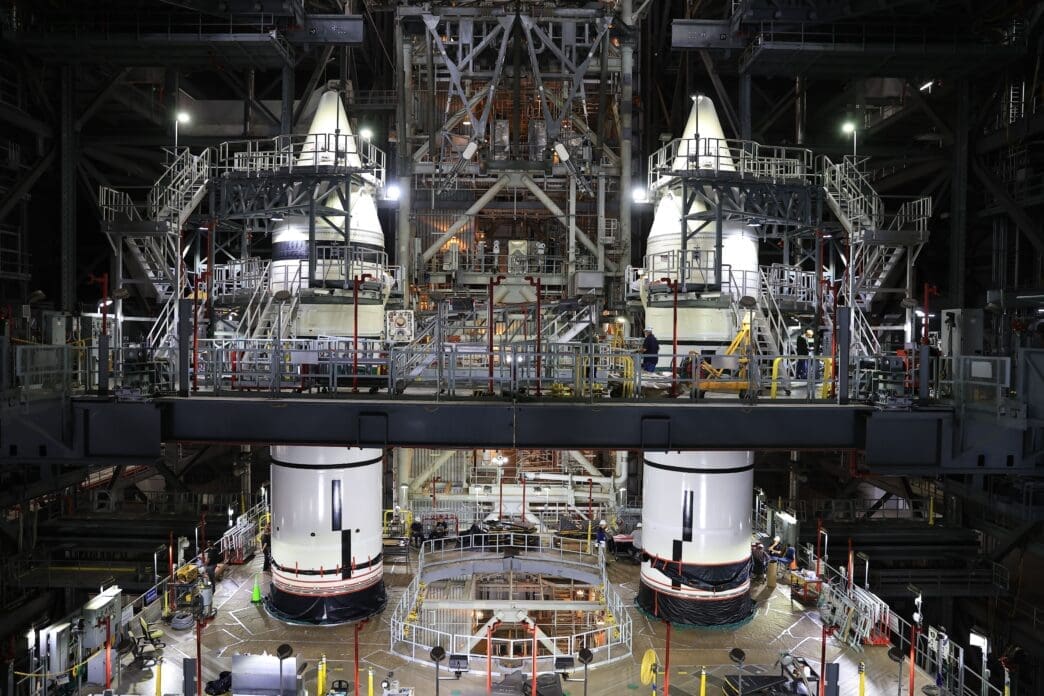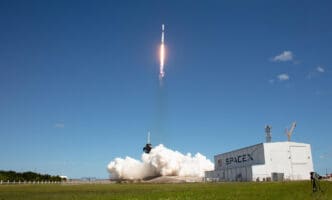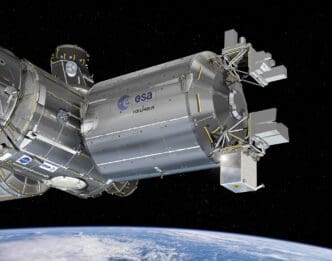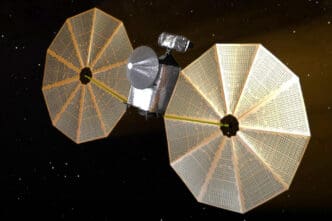Excitement is in the air at NASA’s Kennedy Space Center in Florida. Engineers have successfully completed stacking the twin SLS (Space Launch System) solid rocket boosters. This process is a critical step in preparing for the Artemis II mission, a crewed voyage around the Moon.
The impressive feat was captured in a striking photo dated February 19, 2025. This marks a significant milestone in a journey that began on November 20, 2024. Using a massive overhead crane, technicians systematically placed each booster segment onto the towering Mobile Launcher 1, standing at a height of 380 feet.
A Giant Leap in Preparation
NASA’s Artemis II mission is one step closer to liftoff with the completion of rocket booster stacking. This complex process involved piecing together enormous segments with precision and skill. The sheer size of the boosters adds to the challenge, each playing a crucial role in propelling the spacecraft towards the Moon. It’s a remarkable engineering achievement, showcasing the dedication and expertise of NASA’s teams.
The construction took place within the iconic Vehicle Assembly Building, a landmark at Kennedy Space Center. Here, the gigantic boosters found their place on Mobile Launcher 1, a vital piece of infrastructure for future space endeavors. The stacking process not only required technical know-how but also a strategic approach to ensure everything fits meticulously. The sight of these massive structures aligned perfectly is a testament to human ingenuity.
The Crane That Could
Managing the hefty rocket segments required extraordinary equipment, with a powerful overhead crane stepping into the spotlight. This behemoth was responsible for lifting and placing each booster element, a task demanding both strength and precision.
The crane’s operation was no small feat. It required careful coordination among the team, ensuring each segment was perfectly aligned and securely fastened. As the boosters took shape, it was a moment of triumph for the engineers who had dedicated countless hours to this labor-intensive phase of the mission.
The Mobile Launcher: A Towering Achievement
Standing at 380 feet, Mobile Launcher 1 is more than just a support structure. It plays an integral role in NASA’s Artemis missions.
The mobile launcher’s design allows it to process, assemble, and ultimately launch the SLS and Orion spacecraft. It is a pivotal component in NASA’s quest to return humans to the lunar surface. Witnessing it in action during the booster stacking provides a glimpse into the future of manned space travel.
Engineers utilized this mobile giant to precisely position the solid rocket boosters. Every connection and assembly point had to be exact, cementing the mobile launcher’s role as an indispensable tool in space exploration.
Setting the Stage for the Moon
With the boosters stacked, NASA is setting the stage for Artemis II’s test flight around the Moon.
This mission not only aims to orbit our celestial neighbor but also to pave the way for future lunar exploration.
The Artemis program symbolizes a new era of discovery, aiming for both scientific breakthroughs and human advancement.
From Concept to Reality
The concept of sending humans around the Moon involves meticulous planning and rigorous testing. Artemis II is no exception.
From initial designs to final assembly, each phase is carefully executed to ensure mission success. The stacking of rocket boosters signifies the culmination of years of effort and innovation.
A Collaborative Effort
The successful stacking of Artemis II’s boosters is a result of collaborative efforts.
NASA’s team worked tirelessly, often behind the scenes, to bring this monumental task to fruition.
Their dedication is reflected in the perfectly aligned booster segments, ready for the next phase of this ambitious journey. It’s a testament to teamwork and perseverance.
Looking Ahead: What’s Next?
With booster stacking complete, the Artemis II mission enters a new phase. Preparations are now focused on integrating additional components and conducting thorough testing. Each step brings us closer to the anticipated manned lunar flyby.
As the countdown progresses, excitement builds. The mission represents a crucial step towards establishing a sustainable presence on the Moon, with its success potentially unlocking new opportunities for exploration beyond.
Role of the Artemis Program
The Artemis program is pivotal in NASA’s long-term vision for space exploration. It aims to inspire a new generation of scientists and adventurers.
With missions like Artemis II, NASA plans to establish a foundation for human travel beyond Earth’s orbit. These efforts could redefine what’s possible, pushing the boundaries of our knowledge and capabilities.
Artemis II is not just about reaching the Moon; it’s about igniting imaginations and daring to go further than ever before.
Countdown to Launch
As the Artemis II mission continues to progress, the countdown to launch draws nearer. NASA’s teams remain vigilant, ensuring all systems are go for this historic flight.
The stacking of the rocket boosters marks an important chapter in this incredible journey, one that echoes the ambition and resilience of human spirit.
With each milestone achieved, we step closer to realizing the dream of returning humans to the Moon—a dream that, once fulfilled, promises to open a new era of exploration and discovery.
The completion of the Artemis II rocket booster stacking is a monumental milestone. It brings NASA another step closer to its goal of human lunar exploration. With each achievement, the dream of exploring the Moon, and beyond, becomes more tangible.

